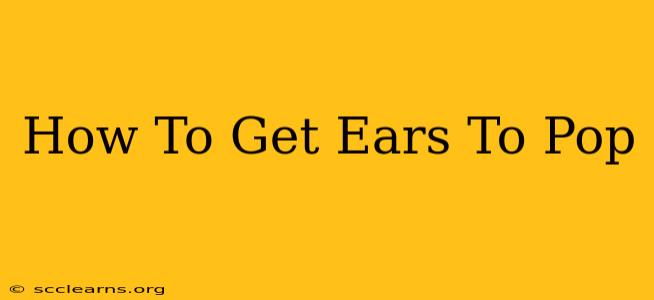Experiencing that uncomfortable pressure in your ears, that feeling of being "plugged up"? It's a common problem, often associated with changes in altitude, such as flying or driving in mountainous areas. This sensation, known as ear popping or ear pressure equalization, happens when the pressure in your middle ear doesn't match the air pressure outside. This guide will help you understand why it happens and provide safe and effective methods on how to get your ears to pop.
Understanding Ear Popping
Before we dive into solutions, let's understand the underlying cause. Your eustachian tubes connect your middle ear to the back of your throat. These tubes usually open and close automatically, allowing air pressure to equalize. However, when the external pressure changes rapidly, they can become blocked, leading to that unpleasant pressure buildup. This is why you feel it during ascents and descents in airplanes or while driving up steep hills.
Common Causes of Blocked Eustachian Tubes:
- Altitude changes: The most common cause. As altitude increases or decreases, the air pressure changes dramatically, leading to pressure imbalances in the ears.
- Colds and Allergies: Inflammation and congestion from these can block the eustachian tubes.
- Sinus Infections: Similar to colds and allergies, infections can lead to swelling and blockage.
- Changes in underwater pressure: Scuba diving and other underwater activities can also cause ear popping.
Safe and Effective Ways to Get Your Ears to Pop
Several techniques can help open your eustachian tubes and relieve the pressure. Here are some of the most common and effective methods:
The Valsalva Maneuver:
This is the most widely known technique. It involves gently closing your mouth, pinching your nose shut, and attempting to exhale forcefully. You should feel a slight pop in your ears as the pressure equalizes. Important Note: Do not force this maneuver. If it doesn't work easily, stop and try another method. Forcing it can cause damage.
The Toynbee Maneuver:
Similar to the Valsalva maneuver, this involves closing your mouth and nose, then swallowing. The act of swallowing helps to open the eustachian tubes. This method is often gentler than the Valsalva maneuver and is a good alternative if the Valsalva maneuver is uncomfortable.
Yawning:
Yawning naturally opens the eustachian tubes. Try to yawn naturally; don't force it.
Swallowing:
Chewing gum, sucking on candy, or simply swallowing repeatedly can also help open the eustachian tubes. The act of swallowing helps to equalize the pressure.
Other helpful tips:
- Stay hydrated: Dehydration can worsen congestion, making it harder for your ears to pop.
- Avoid smoking: Smoking irritates the respiratory system and can exacerbate ear pressure issues.
- Use a nasal decongestant: If you have a cold or allergies, a nasal spray might help clear your nasal passages, indirectly improving eustachian tube function. Always follow the instructions on the product label.
When to Seek Medical Attention
While these methods are generally safe and effective, it's crucial to seek medical advice if:
- Ear pain persists: Severe or persistent ear pain could indicate a more serious problem.
- You experience hearing loss: A sudden change in hearing should be checked by a doctor.
- You have a fever: This could signify an infection.
- These methods do not provide relief: If you've tried several techniques and still have ear pressure, consult a doctor.
This comprehensive guide should provide you with the necessary information to manage ear popping effectively. Remember to always listen to your body and consult a healthcare professional if you have any concerns. Don't suffer in silence – take control and get your ears to pop!

